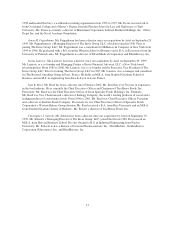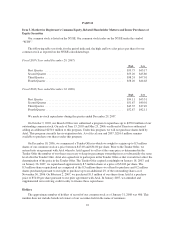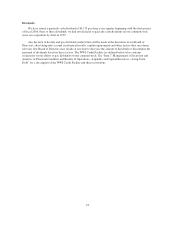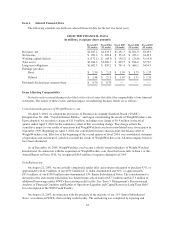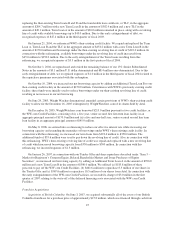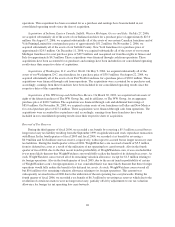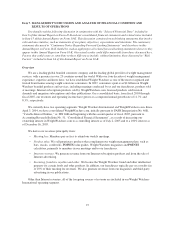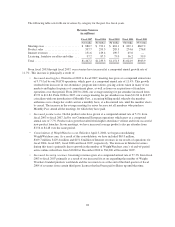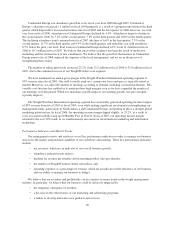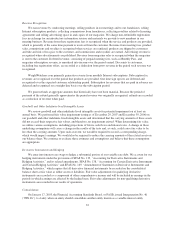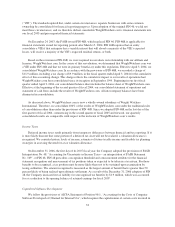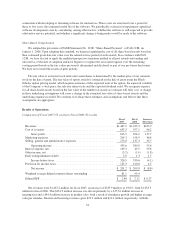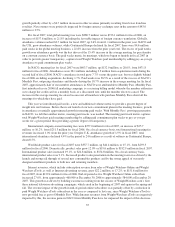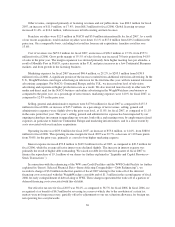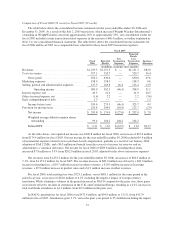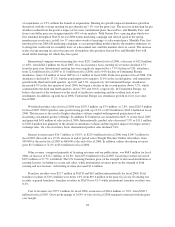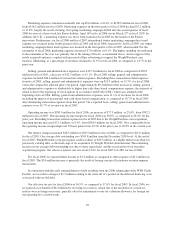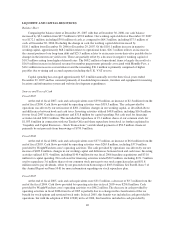WeightWatchers 2007 Annual Report Download - page 43
Download and view the complete annual report
Please find page 43 of the 2007 WeightWatchers annual report below. You can navigate through the pages in the report by either clicking on the pages listed below, or by using the keyword search tool below to find specific information within the annual report.Continental Europe saw attendance growth in every fiscal year from 2000 through 2005. Continental
Europe’s attendance increased 1.1 million in fiscal 2004 primarily as a result of a program innovation in the third
quarter which helped drive increased attendance into fiscal 2005 and the first quarter of 2006; however, on a full
year basis in fiscal 2006, attendances in Continental Europe declined by 4.4%. Attendances began to decline in
the second quarter 2006, by 7.2% in the second quarter, 7.8% in the third quarter and 10.6% in the fourth quarter.
The declining attendance trend continued into fiscal 2007 (declines of 6.6% in the first quarter, 7.5% in the
second quarter, 11.7% in the third quarter and 9.4% in the fourth quarter) and ended the year with attendance
8.5% below the prior year level. Paid weeks in Continental Europe declined 6.2%, from 11.4 million in fiscal
2006 to 10.7 million in fiscal 2007. We believe that most of this weakness has been the result of ineffective
marketing and the resultant lack of new enrollments. We believe that the growth of the business in Continental
Europe prior to fiscal 2006 outpaced the expertise of the local management, and we are in the process of
strengthening these teams.
The number of online paid weeks increased 23.2%, from 25.2 million in fiscal 2006 to 31.0 million in fiscal
2007, due to the continued success of our WeightWatchers.com segment.
We have maintained an annual gross margin in the Weight Watchers International operating segment of
50% or more since fiscal 2001. Our staff is usually paid on a commission basis and space is typically rented as
needed. Moreover, we adjust the number of meetings according to demand, including seasonal fluctuations. This
variable cost structure has enabled us to maintain these high margins even as we have expanded the number of
our meetings over this period. When our attendance growth outpaces our meeting growth, our gross margins
typically improve.
The Weight Watchers International operating segment has consistently generated operating income margins
of 30% or more from fiscal 2001 to fiscal 2005, even while making significant investments in strengthening our
management teams, particularly in North America and Continental Europe, and putting in place a stronger global
marketing infrastructure. In fiscal 2006, the operating income margin dipped slightly, to 29.2%, as a result of
costs associated with the ramp up of Monthly Pass in NACO. In fiscal 2007, our operating income margin
returned to the over 30% mark, as we simultaneously increased our investments in marketing and information
technology.
Performance Indicators and Market Trends
Our management reviews and analyzes several key performance indicators in order to manage our business
and assess the quality and potential variability of our cash flows and earnings. These key performance indicators
include:
• net revenues, which are an indicator of our overall business growth;
• attendance and paid weeks metrics;
• meeting fee revenue per attendee and in-meeting product sales per attendee;
• the number of WeightWatchers Online subscribers; and
• operating expenses as a percentage of revenue, which are an indicator of the efficiency of our business
and our ability to manage our business to budget.
We believe that our revenues and profitability can be sensitive to major trends in the weight management
industry. In particular, we believe that our business could be adversely impacted by:
• the temporary emergence of fad diets;
• a decrease in the effectiveness of our marketing and advertising programs;
• a failure to develop innovative new products and services;
30



